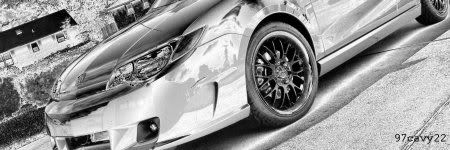Some of these have been going around the internet for a while but this isnt just that same list powsted again, there is plenty of new/updated facts, actual quotes form drivers etc
---------
* One dragster's 500-inch Hemi makes more horsepower then the first 4 rows at a Nascar race
* One cylinder from a dragsters engine makes more power then an engine used in F1 racecar.
* Of the engine used the block and heads are CNC-milled from solid billets of aluminum, and the oil pan is titanium.
* $58,700 is the cost for a new, ready-to-run Top Fuel engine.
* It takes 29 Minutes it takes to tear down and rebuild a Top Fuel engine between rounds. Each engine is rebuilt 184 times a year (if the driver goes to the final round at every race).
* Top Fuel dragsters have a power-to-weight ratio of 3.37 horsepower per pound, about 20 times better than the new Z06 Corvette's.
* a Top Fuel dragster has a 300 inch wheelbase which is made from about 3000 inches of chrome-moly tubing needed to build the frame, which is left unpainted because of the need to constantly weld cracks.
* $1082 will buy a pair of new Goodyear R36x17.5 rear slicks. If you're lucky, they'll last you a bit over a mile - four runs.
* Under full throttle, a dragster engine consumes 1 1/2 gallons of nitro per second, the same rate of fuel consumption as a fully loaded 747 but with 4 times the energy volume.
* The supercharger takes more power to drive than a stock hemi makes.
* Even with nearly 3000 CFM of air being rammed in by the supercharger on overdrive, the fuel mixture is compressed into nearly-solid form before ignition. Cylinders run on the verge of hydraulic lock.
* Dual magnetos apply 44 amps to each spark plug. This is the output of an arc welder in each cylinder.
* At stoichiometric (exact) 1.7:1 air/fuel mixture (for nitro), the flame front of nitromethane measures 7050 degrees F.
* Nitromethane burns yellow. The spectacular white flame seen above the stacks at night is raw burning hydrogen, dissociated from atmospheric water vapor by the searing exhaust gases.
* Spark plug electrodes are totally consumed during a pass. After 1/2 way, the engine is dieseling from compression-plus the glow of exhaust valves at 1400 degrees F. The engine can only be shut down by cutting off its fuel flow.
* Top Fuel dragsters are the fastest linear accelerating vehicles in the world, nothing can keep up.
* If spark momentarily fails early in the run, unburned nitro builds up in those cylinders and then explodes with a force that can blow cylinder heads off the block in pieces or blow the block in half.
* Maximum boost produced by the supercharger at wide-open throttle is 45.5 PSI.
* Dragsters twist the crank (torsionally) so far (20 degrees in the big end of the track) that sometimes cam lobes are ground offset from front to rear to re-phase the valve timing somewhere closer to synchronization with the pistons.
* To exceed 300mph in 4.5 seconds dragsters must accelerate at an average of over 4G's. But in reaching 200 mph well before 1/2 track, launch acceleration is closer to 8G's.
* If all the equipment is paid off, the crew worked for free, and for once NOTHING BLOWS UP, each run costs $1000.00 per second.
* The exhuast exits the headers at speeds over Mach 1, the exhaust actually provide downforce as well as forward THRUST.
* The downforce provided by the exhaust coming from the zoomie headers at peak value rivals that provided by the the spoiler/wing on the front of the car.
* A single Top Fuel Dragster launch measures up to 2.0 on the Richter scale, which is used to measure earthquakes, the energy produced is the equivalent of a little over 1 metric ton of TNT, the same as the explosion cause from a late WWII conventional air dropped bomb.
* A top fuel car at full throttle can be heard from over 8 miles away.
* Dragsters reach over 300 miles per hour before you have read this sentence.
Did you know
that the nitromethane-powered engines of NHRA Top Fuel dragsters and Funny cars produce approximately 7,000 horsepower, about 37 times that of the average street car?
that one cylinder of the eight cylinders of a Top Fuel dragster or a Funny Car produces 750 horsepower, equaling the entire horsepower output of a NASCAR engine?
that the gasoline-powered engines of NHRA Pro Stock cars produce about 1,200 horsepower, about eight times that of the average street car?
that an NHRA Top Fuel dragster accelerates from 0 to 100 mph in less than .8-second, almost 11 seconds quicker than it takes a production Porsche 911 Turbo to reach the same speed?
that an NHRA Top Fuel dragster leaves the starting line with a force nearly five times that of gravity, the same force of the space shuttle when it leaves the launching pad at Cape Canaveral?
that an NHRA Funny Car is slowed by a reverse force more than seven times that of gravity when both parachutes deploy simultaneously?
that NHRA Top Fuel dragsters and Funny Cars consume between four and five gallons of fuel during a quarter-mile run, which is equivalent to between 16 and 20 gallons per mile?
that NHRA Top Fuel dragsters and Funny Cars use between 10 and 12 gallons of fuel for a complete pass, including the burnout, backup to the starting line, and quarter-mile run?
that NHRA Top Fuel dragsters and Funny Cars travel the length of more than four football fields in less than five seconds?
that NHRA Top Fuel dragsters can exceed 280 mph in just 660 feet?
that from a standing start, NHRA Top Fuel dragsters accelerate faster than a jumbo jet, a fighter jet, and a Formula One race car?
that a fuel pump for an NHRA Top Fuel dragster and Funny Car delivers 65 gallons of fuel per minute, equivalent to eight bathroom showers running at the same time?
that the fuel-line pressure for NHRA Top Fuel dragsters and Funny Cars is between 400 and 500 pounds, about 20 times greater than the pressure on passenger-car fuel pumps?
that depending on size and angle, the large rear wing on an NHRA Top Fuel dragster develops between 4,000 and 8,000 pounds of downforce?
that the 17-inch rear tires used on NHRA Top Fuel dragsters and Funny Cars wear out after four to six runs, or about two miles? Some brands of passenger-car tires are guaranteed for 80,000 miles.
that it takes just 15/100ths of a second for all 7,000 horsepower of an NHRA Top Fuel dragster engine to reach the rear wheels?
that it's desirable for an NHRA Top Fuel dragster to race with its front wheels inches off the ground for about the first 200 feet of the run? This ensures proper weight transfer to the rear wheels, a crucial part of a good launch and quick run.
that the nitromethane used to power the engines of NHRA Top Fuel dragsters and Funny Cars costs about $30 per gallon?
Putting all of this into perspective: You are driving the average $240,000 NASCAR Winston Cup racecar. Over a mile up the road, a Top Fuel dragster is staged and ready to launch down a quarter mile strip as you pass. You have the advantage of a flying start. You run the stock car hard up through the gears and blast across the starting line and past the dragster at an honest 200 mph. The 'tree' goes green for both of you at that moment.
The dragster launches and starts after you. You keep your foot down hard, but you hear an incredibly brutal whine that sears your eardrums and within 3 seconds the dragster catches and passes you. He beats you to the finish line, a quarter mile away from where you just passed him. Think about it, from a standing start, the dragster had spotted you 200 mph and not only caught, but nearly blasted you off the road when he passed you within a mere 1320 foot long race course..
I spent a few days recently reviewing the voluminous collection of newspaper clippings and online articles archived weekly in 2003 by NHRA.com for the enlightenment of our fans, and I reveled in the ways that writers and racers describe our sport.
For example, Scott Hennen, sports editor for the Newark Advocate, explained to his readers the competitiveness of the Pro Stock class thusly: "Twenty-eight one-[thousandths] of a second. Less than a blink of an eye. Three to four feet as a car approaches 200 mph. Faster than you can say, 'Jegs.' That's the difference between the top-qualifying car each week in the National Hot Rod Association's Pro Stock division and the just-under-the-wire No. 16 qualifier in an elimination bracket"
Richard Gray of Arizona's East Valley Tribune, offered his impression of the rip-snorting Funny Car class and drag racers in general: "There's nothing funny about Funny Cars. They are brutes, 6,000-horsepower monsters, unforgiving and hard to handle all the way down the dragstrip, and the margin for error is slim ... racers are the contemporary equivalents of Roman gladiators. Every time they strap in, the job is survival, be it career-- sustaining points or life itself."
The racers themselves offered interesting observations. When Mark Decotis of Florida Today told John Force that he imagined driving a Funny Car was comparable to being strapped in a cage with a time bomb sitting in your lap, Force responded matter-of-factly, "That's the nature of the beast, no different than [how] a bullfighter gets a horn every now and then."
Top Fuel racer David Baca told Joe Stiglich of the Contra Costa Times, "These are the fastest-accelerating vehicles on the planet. They're very finicky, very temperamental. Sometimes they're like a woman: You have to treat them just right or they get mad at you or blow up."
Pro Stock Bike ace Antron Brown explained to Pete Schnatz of the Philadelphia Inquirer, "You rip that throttle and it sends a vibration through you and blurs your vision. There are no seat belts, no harnesses only a helmet, a leather racing suit, and your bike between you and the track. You're sitting 20 inches off the ground, going from zero to 60 mph in one second. It's an unreal rush."
At the Mac Tools NHRA Gatornationals, photographer Courtney Willinger, who was on assignment in Bob Gilbertson's Team Raybestos camp and shooting her first drag race, shared her first impression of the sport with an eloquent observation that left many longtime fans who could never find just the right words, saying, "Yeah, what she said!"
"The word 'concussion' now has new meaning," Willinger said. "It's 4.0 on the Richter scale, a deafening explosion, breathtaking and fierce, extreme in every sense of the word, and, strangely enough, manmade. Drag racing is an awesome and highly interactive sport. I can't be sure which part of it is more exciting - watching a crew of eight specialists build a car from the bare chassis up in 75 minutes, seeing the car whiz by at 315 mph, or feeling the initial blast of nitromethane that powers the car to accelerate to more than 100 mph in less than a second.
"The sheer excitement that comes from extreme speed and sound brings an involuntary and satisfying tribal yell," Willinger continued. "The ground shakes severely, and your body goes through an overwhelming sensory overload. The sight of something moving so fast, the sound that makes the Doppler effect quite an understandable idea - sound in motion, sound being pushed, and the pressure of a sound that takes your breath away - leaves you temporarily still while the car in front of you catapults away. The feeling of the vibration of the ground underneath you, the blast from the exhaust of the car, the burning smell of rubber and nitromethane exhaust, and the taste of the courage, skill, and teamwork that lead to breaking speed records are extreme."



 -Chris
-Chris



